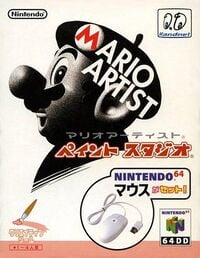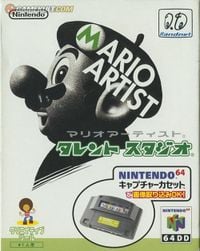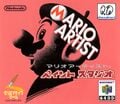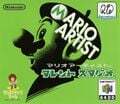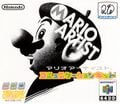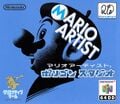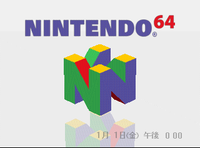64DD
| 64DD | |
|---|---|
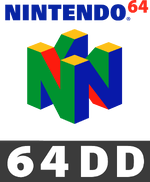 Official logo 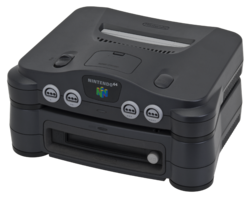 A 64DD attached to a Nintendo 64 | |
| Generation | Fifth generation |
| Release dates | |
| Discontinued | February 28, 2001[2] |
| Predecessor | Satellaview |
- “The 64DD sat under your N64. Well, not yours — you didn't have a 64DD.”
- —Official Nintendo Magazine
The 64DD, also called the Nintendo 64DD[3] (tentatively called the Nintendo 64 Disk Drive before release),[4] is a disk drive unit that, like the Family Computer Disk System, attaches to a Nintendo 64 and can play games in a magnetic disk format, with the disks containing their own internal memory written through the N64 instead of the disk itself. There were also several peripherals used for it. The system was released only in Japan in December 1999, following numerous developmental delays,[citation needed] and it was scheduled for release in North America in 2000. The system was released through subscription to the Randnet online service run by RandnetDD (a joint-venture between Nintendo and Recruit), which came with a Randnet disk that allowed the user to browse the internet on the console and access exclusive content (such as Net Studio and Mario Artist Dojo). Due to its belated Japanese release and due to the way it was sold, the system ended up being a commercial failure; consequently, the planned American release was canceled, and the device was ultimately never released outside Japan.
There were four games of the Super Mario franchise released on this console, all in the Mario Artist series; there were also several canceled Super Mario titles. Overall, there were only ten games released on the 64DD, although other games planned for the console were released on the original Nintendo 64, the Sony PlayStation, the Sega Dreamcast, and the next-generation Nintendo GameCube or were canceled altogether.
Accessories[edit]
The title of this section is official, but it comes from a Japanese source.
If an acceptable English name is found, then the section should be changed to the new title.
Mouse[edit]
The Mouse (マウス Mausu,[5][6] model no. NUS-017) is a computer mouse which can be plugged into a controller port of the original Nintendo 64. It replaces analog stick input to allow more precise cursor movements in games that support it, such as the Mario Artist series; a Mouse was in fact bundled with Mario Artist: Paint Studio. It is comparable to the Super NES Mouse.
Modem[edit]
The Modem (モデム Modemu,[5] model no. NUS-029) is a device resembling a Nintendo 64 game cartridge, and could be plugged into the cartridge slot on top of the Nintendo 64, allowing it to connect to Randnet. Mario Artist: Communication Kit made use of this accessory for its Net Studio mode.
Capture Cassette[edit]
The Capture Cassette (キャプチャーカセット Kyapuchā Kasetto,[5][7] model no. NUS-028) is a device resembling a Nintendo 64 game cartridge with AV input slots. When plugged into the cartridge slot of the Nintendo 64, the Capture Cassette allows the system to take in RCA and microphone as input. This accessory was bundled with Mario Artist: Talent Studio, which makes use of it for video capture. This accessory is also used by Mario Artist: Communication Kit for its Capture de Asobu mode.
Super Mario games[edit]
Released[edit]
- Mario Artist: Paint Studio
- Mario Artist: Talent Studio
- Mario Artist: Communication Kit
- Mario Artist: Polygon Studio
Canceled[edit]
- Mario Artist: Sound Studio
- Mario Party
- Mario Party 2
- Super Mario 64 2
- Super Mario 64: Disk Ban[8][9]
- Super Mario RPG 2 (released on the Nintendo 64 as Paper Mario)
Game gallery[edit]
Multimedia[edit]
| File info 0:05 |
Notes[edit]
- If there is no game inserted in the system, the start-up appears as usual, but Mario then appears and plays around with the Nintendo 64 logo. The N shape changes when Mario interacts with it.[10]
- Mario Party originally was supposed to be compatible with the 64DD, suggesting that Mario Party 2 was originally supposed to serve as an expansion disk to it.[11]
- Rainbow Road in F-Zero X has added functionality when the player uses the 64DD disk F-Zero X Expansion Kit, with which a rock version of the Mario Kart 64 track version's theme is played when the player drives on that racetrack.
Names in other languages[edit]
| Language | Name | Meaning | Notes |
|---|---|---|---|
| Japanese | Rokuyon Dīdī |
64DD | |
| Dutch | 64DD[13] | - | |
| French (Europe) | 64DD[14] | - | |
| German | 64DD[15] | - | |
| Italian | 64DD[16] | - | |
| Portuguese (Europe) | 64DD[17] | - | |
| Spanish (Europe) | 64DD[18] | - |
References[edit]
- ^ Chris Kholer (December 18, 2018). The 64DD Was One Of Nintendo's Oddest Experiments. Kotaku (English). Retrieved January 20, 2025. (Archived July 2, 2019, 19:50:37 UTC via Wayback Machine.)
- ^ ランドネットホームページ. Randnet (Japanese). Archived April 13, 2001, 23:46:43 UTC from the original via Wayback Machine. Retrieved May 25, 2024.
- ^ Iwata Asks - The Legend of Zelda: Ocarina of Time 3D Original Development Staff - Part 1 - Page 5. Nintendo.com.
- ^ Nintendo 64 Disk Drive Pre-release console. Consolevariations. Retrieved October 27, 2025.
- ^ a b c File:MarioArtistCommunicationKitBack.jpg
- ^ File:MAPaintStudio2.jpg
- ^ File:MATalentStudio2.jpg
- ^ Bodamin, Kadu. Super Mario 64 Disk Version existe? Fã mostra em vídeo esta curiosa versão do game rodando em Nintendo 64 japonês. Reino do Cogumelo (Portuguese). Retrieved May 25, 2024.
- ^ Kim, Byungsuk (June 24, 2014). Super Mario 64DD Version Discovered in Japan. Gaming After Hours. Retrieved May 25, 2024.
- ^ Benaim, Jason (May 5, 2013). 64DD emulation test. YouTube. Retrieved February 9, 2016.
- ^ adonfjv (June 18, 2009). Mario Party PAL with 64DD error 31 gameshark. YouTube. Retrieved May 12, 2018.
- ^ Packaging
- ^ Iwata vraagt: 1. Van Zelda tot Wii Fit. Nintendo (Dutch). Retrieved October 31, 2025. (Archived July 10, 2025 via Wayback Machine.)
- ^ Iwata demande: 1. De Zelda à Wii Fit. Nintendo (French). Retrieved October 31, 2025. (Archived July 10, 2025 via Wayback Machine.)
- ^ Iwata fragt: 1. Von Zelda zu Wii Fit. Nintendo (German). Retrieved October 31, 2025. (Archived July 8, 2025 via Wayback Machine.)
- ^ Iwata Chiede: 1. Da Zelda a Wii Fit. Nintendo (Italian). Retrieved October 31, 2025. (Archived July 10, 2025 via Wayback Machine.)
- ^ Iwata Pergunta: 1. De Zelda a Wii Fit. Nintendo (Portuguese). Retrieved October 31, 2025. (Archived July 10, 2025 via Wayback Machine.)
- ^ Iwata Pregunta: 1. De Zelda a Wii Fit. Nintendo (Spanish). Retrieved October 31, 2025. (Archived July 10, 2025 via Wayback Machine.)
| Nintendo 64 games | |
|---|---|
| Super Mario franchise | Super Mario 64† (1996) • Mario Kart 64† (1996) • Mario no Photopi (1998) • Mario Party (1998) • Mario Golf (1999) • Mario Artist: Paint Studio* (1999) • Mario Party 2 (1999) • Mario Artist: Talent Studio* (2000) • Mario Artist: Communication Kit* (2000) • Mario Tennis (2000) • Paper Mario† (2000) • Mario Artist: Polygon Studio* (2000) • Mario Party 3 (2000) • Dr. Mario 64† (2001) |
| Donkey Kong franchise | Diddy Kong Racing (1997) • Donkey Kong 64 (1999) |
| Yoshi franchise | Yoshi's Story† (1997) |
| Crossovers | Super Smash Bros.† (1999) |
